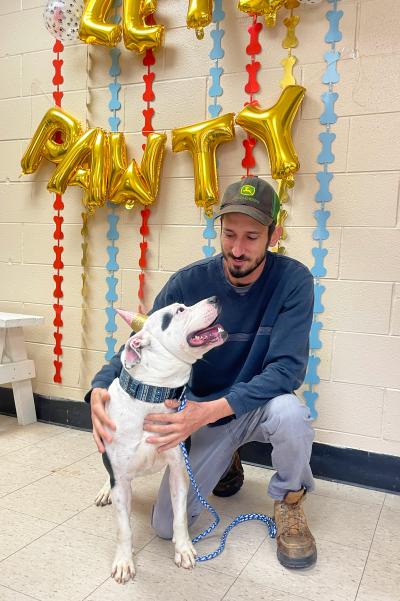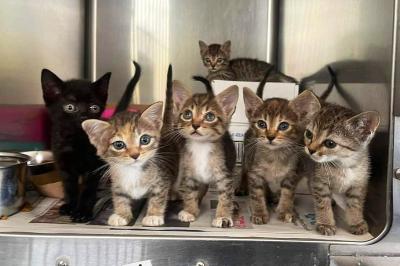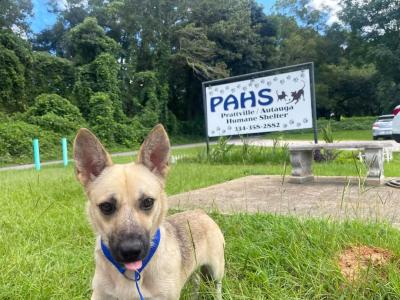A new day for animals at an Alabama shelter

Eight months ago, no one at Prattville/Autauga Humane Society (PAHS) in Alabama would have imagined they’d be throwing a going-away party for Sadie, complete with cupcakes and presents (and Sadie decked out in her famous holiday pajamas). After all, the rambunctious three-year-old pit bull terrier appeared to be the kind of dog who probably would have been on the shelter’s euthanasia list in years past.
“She frightened some people because she would jump at the kennel door when they walked by,” says Jakie Hernandez. Jakie is a Best Friends staff person working for a year as the operations manager at PAHS. She’s one of several people working in shelters around the country as part of the Best Friends national shelter embed program, made possible in part by a grant from Maddie’s Fund®.
The program supports and assists shelter staff in many ways, so they have more celebrations for adoptions like Sadie’s. But adoptions are just one part of the puzzle. As we progress toward the goal of every shelter in every community reaching no-kill by 2025, that means finding out what shelters need to save more lives. In Prattville, the staff were eager to do it.

Supporting a goal to reach no-kill
Prattville/Autauga Humane Society struggled with a low save rate; at the time Best Friends approached them, less than 50% of dogs and cats were leaving the shelter alive each year. The shelter staff wanted to do a lot more for the community’s animals. So they opened their doors to Best Friends.
It began with an assessment, where Best Friends staff visits a shelter with the goal of advising on how they can save more dogs and cats. PAHS shelter director Claudia Rigsby says she was initially concerned about what they might find when they assessed practices at PAHS.
“I wondered whether we were doing all we could for each animal that comes into our shelter,” Claudia says. “Will we be able to implement the changes and make them work for our particular shelter? Will the staff and board be willing to step up to make the changes necessary to make this a successful partnership? Above all, can PAHS become a no-kill shelter?”
The assessment came with offers of help — the most significant was to place a Best Friends staff person at the shelter to work alongside them for a year. “We felt they would benefit the most from hands-on help to get new processes to stick,” says Destiny Haney, senior manager of Best Friends’ national embed program.
That’s how Jakie Hernandez ended up moving to Alabama to work at PAHS as their operations manager for a year.
Jakie is particularly suited to shepherding shelter staff through change because she has walked in their shoes. Prior to stepping in to help PAHS, she worked at two shelters with embedded Best Friends staff — San Antonio Animal Care Services and Abilene Animal Services.
“I know what it feels like to be on the other side as an employee,” Jakie says. “There are always doubts at first. I definitely remember thinking ‘What are they talking about?’ Now I get to be that person who goes to different shelters and helps turn big promises into reality.”

Curbing disease outbreaks
The first step in the embed program is to start with the “low-hanging fruit.” In PAHS’ case, that meant introducing new cleaning methods to make an immediate impact on the health of the animals. Setting the reset button on how the staff clean and disinfect the kennels meant practically right away far fewer cats were going into the isolation ward with serious illnesses.
Asking people to do their jobs differently isn’t always easy, but because she’s been the one asked to make changes in her previous roles, Jakie can empathize with the shelter staff. “I just remind them that nobody at Best Friends is here to judge anybody,” Jakie says. “There is no failure; things will not be perfect. But progress happens when we keep trying new things.”
PAHS was also grappling with an outbreak of parvo, a highly contagious viral infection in dogs, when Best Friends first got involved. That meant there was an urgent need to help sick dogs overcome the virus as well as to stave off future outbreaks by putting vaccine protocols in place.
[Parvo is no match for Maltese-mix puppy]
“Vaccinating dogs against parvo the minute they come into the shelter went a long way for them to see progress on a big problem,” Destiny says.
Another big change was with the cats and kittens who got ringworm, a fungal infection that many shelters — PAHS included — don’t treat because of how contagious it is. When several kittens were diagnosed with ringworm, Jakie and one of the shelter’s foster volunteers stepped up to take kittens home and nurse them back to health.
“We cleared them of ringworm in a month and put them back up for adoption,” Jakie says. “They were all adopted within 48 hours. That's something that was unheard of at PAHS.”
“It was a light-bulb moment for them, as they saw how capable they are of making a difference,” Jakie adds. “Now, I think they’re willing to try pretty much anything if it means saving more lives.”

Animal shelter upgrades
Jakie also looked at how PAHS was making decisions about which animals needed to be admitted to the shelter right away and which could be delayed. For the latter, staff supported the public with guidance on how to rehome animals on their own.
“We had to look at the flow of dogs and cats into the shelter, so it wasn’t being inundated,” Jakie says. “It's a very small facility, and the kennels can fill up very quickly. That meant we had to coach shelter staff and animal control officers on becoming comfortable with open, kind and honest conversations with the public about what the shelter can and can't do for the animals that they're trying to bring in.”
Changes at the shelter were going well, and the team was ready to try new things to better help dogs — especially dogs like Sadie. But first, the facility needed a bit of work. Best Friends sent a team from the Sanctuary’s maintenance department to do some much-needed work at the shelter.
“The doors that allow staff to close the dogs off into half of the kennel while they clean or to create space to accommodate more dogs were completely rusted through in some cases,” says Destiny. “PAHS was using cardboard, so some of our maintenance staff came out to refurbish those. They also cleaned up several outside areas to allow for play groups.”

Play groups and dog training
Best Friends national shelter support specialist Tierney Sain traveled to PAHS to work alongside the staff and show them some new ways to help dogs during their stay at the shelter and ultimately to help them get adopted more quickly.
Tierney taught the PAHS staff how to run play groups and work with dogs who didn’t have the best behavior in their kennels, like Sadie. Jakie says, “She just has a lot of energy. She’d been living in the kennels for months, and the longer she was there, the more stir-crazy she became. Lead animal care technician Steven Forrester dedicated himself to Sadie’s cause. He helped her learn some basics like not jumping up on people and walking nicely on leash. That made life a lot better for Sadie and those taking care of her.
[Enrichment for Dogs in Shelters]
Sadie also joined play groups, and that’s where she really shined. As it turns out, she was so great with other dogs that she became a role model for the less-social canines and eventually graduated to going on sleepovers.
It was another step in the right direction that would soon lead her, and more dogs like her, home.

More adoptions
Once PAHS got a handle on the number of animals coming into the shelter, it was time to turn their attention to helping more animals leave. Right off the bat, the shelter’s participation in Best Friends’ May national adoption weekend netted great results: 17 dogs and cats were adopted compared to nine during the same time period in 2021.
[Thousands of pets go home, thanks to Bounty]
PAHS went on to see similar results at three more adoption weekends sponsored by Best Friends in 2022. The July event saw 37 cats and dogs going to new homes compared to 14 for the same 2021 weekend. The September event resulted in 14 adoptions compared to three the previous year. And nine animals were adopted at the December event compared to six the year prior.
“We love these events because the atmosphere at the shelter, although very busy, is fun and upbeat the way shelters should be,” Claudia says. “These events are very good for staff morale.”
Also great for staff morale is seeing long-time residents, like Sadie, leave with new families. Once people could see who Sadie really was, and that her behavioral challenges only showed up in a shelter environment, it wasn’t long before she got adopted.
She went home with a young couple and gained a husky brother, and she’s not PAHS’ only such resident to go home. After 129 days in the shelter, a dog named Daniel now has a job as an emotional support dog for a man who has anxiety. Pit bull mix Maddie went to a home with a young child after 118 days at PAHS. And Rhodesian ridgeback Big Red wrapped up his 114-day stay by waltzing out the door with several college students.
It’s been a lot of hard work, but the dedicated team at PAHS is doing a great job. The goal is to help them save more dogs and cats for years to come. Their save rate is steadily increasing, and it’s still only the beginning of a new way of life.
Claudia says, “Each one of the Best Friends staff who has been involved with PAHS has instilled a wealth of knowledge from their experiences and taught us how to continue to obtain that knowledge long after they have gone.”

Make a difference
Help animals through a Best Friends Network partner like Prattville/Autauga Humane Society.
Read more
Grant Parish in Louisiana goes to the dogs